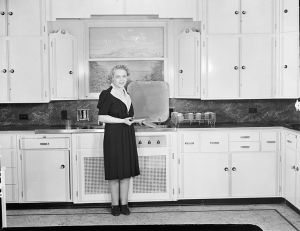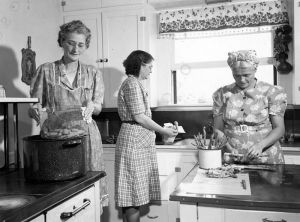Kate Whiston, University of Nottingham
In a recent article, Meah (2016) discusses the space of the kitchen – seemingly mundane and neglected by geographical study – and the ways in which it has evolved through time to become more than just a food preparation area for the confinement of women.
“A woman’s place is in the kitchen” is a well-known, oft-used phrase. Last month, BT Sport presenter Lynsey Hipgrave was subjected to this type of misogynistic abuse on social media following her criticism of Lionel Messi’s controversial un-sportsmanlike penalty. Amongst the sexist replies she received were; “we need sandwiches not opinions” and “somewhere there’s a kitchen and it’s missing something”. Whilst there are some who still rigidly live by this sexist mantra, there is lots of evidence that such marginalisation of women using sexist delineations of space is starting to be dispelled. Whilst Nigella Lawson’s heavily sexualised cookery programmes do women’s cause no favours, the proliferation of successful male chefs on The Great British Bake Off, in reputable restaurants, and as celebrity chefs, suggest that kitchen culture is changing. In a recent article in the Independent, French Chef Alain Ducasse, owner of 23 Michelin-star restaurants in seven countries, suggested that the changing ‘macho kitchen culture’ was displacing the old sexist stereotype. Ducasse even highlighted a lack of female chefs in France, leading him to establish the ‘Femmes en Avenir’ (Women of the Future) programme in association with the French government in 2011. The programme encourages women in the outskirts of Paris to gain culinary qualifications, in order to pursue a career in cooking.
Meah’s (2016) article provides the historical background that explains why women have long been associated with the kitchen. Historically, the kitchen was a space occupied by working class women, either as maids or cooks for the wealthy, or in their own kitchens. The kitchen was at the rear of the house, out of public view; gendered labour concealed from the rest of society. This is similar to Erving Goffman’s (1959) The Presentation of Self in Everyday Life, in which he explains how our identities are performed sometimes less explicitly, hidden from others, in what he calls the ‘back stage’. The kitchen became the symbolic heart of domesticity and the women that produced this sense of domesticity were often marginalised.
Meah (2016), however, argues that the kitchen was transformed from a space of production to a space of consumption, with the evolution of modern kitchen design in the twentieth century, the kitchen becoming an ideological battle ground. Mass housing projects during the inter-war period, she argues, favoured standardised, modernist kitchen spaces, designed to be efficient and functional. By scientifically arranging space within the kitchen to make it more productive, daily life and behaviour were also changed. Functionalist designers of the 1930s saw the repetitive and productive model of factory assembly lines as the ideal method for both easing the housewife’s work and making it more efficient. By reducing the housewife’s need to move around the kitchen, making everything within reaching distance, the routinisation of her work meant cooking was less of a pleasure and more of a practical task. Moving into the 1940s, Meah (2016) traces the emergence of the kitchen-living room arrangement, a space which enabled families to eat their meals in a separate space to the food preparation area, but a low-partition wall meant that the housewife was not isolated whilst at work in the kitchen. Open-plan living spaces, therefore, further redefined the kitchen, showing the resistance of both women and kitchen spaces.

Meah (2016) identifies another societal change, still seen today, which further changed the culture of kitchens. By the 1950s, she argues, women were engaged in paid employment outside the home, becoming increasingly independent and industrious. We see this today to an even greater extent, with the employment of women in some really prominent positions such as merchant bankers, lawyers, doctors, or business owners. The emergence of the career-orientated woman has further led to the separation of women from the kitchen, as they no longer have the time or the inclination to slave away in the kitchen for hours preparing food whilst their husbands work all day. Societal transformations in work, leisure, and gender roles have transformed the kitchen into, what Meah (2016), calls an ‘orchestrating concept’. Kitchens have become spaces where numerous practices and elements are structured and held together, making it both material and symbolic. They are arenas for the performance of everyday life; be it food preparation and eating, playing out relationships with family members and hosting parties, or many non-food activities such as watching TV, reading the paper, and caring for pets.
The personalisation, and sometimes feminisation, of the kitchen space has altered the ways in which kitchens are experienced and consumed. Most notably, the aesthetic of the kitchen is used as an expression of identity. Meah (2016) argues that the space of the kitchen has become a site of memory, a sort of private museum, in which personal objects are kept and displayed which tell personal stories. Collectible silverware, wedding china, and other gifts are often displayed in the kitchen, prized possessions that each have their own story to tell. Fridges and notice boards display collages of mementos and snapshots of lives; fridge-magnet souvenirs, postcards, children’s drawings, photographs, appointment cards, party invitations, and ticket stubs are just a few of the items that may make up such an eclectic archive of family history. This not only shows the portability of memory, but also transforms the kitchen from a space, used and lived in, to a meaningful place of personal importance.
The kitchen has therefore undergone many changes through history, becoming more than just a space for women to make food. Women have also been transformed; from passive consumers and oppressed labourers to active participants in a meaningful and constantly changing space.
Meah, A. (2016). “Extending the Contested Spaces of the Modern Kitchen”, Geography Compass, 10(2):41-55.
Guardian Sport (2016) Lynsey Hipgrave hits out at sexist abuse after criticising Lionel Messi
Casey, L. (2016) Alain Ducasse interview: The French chef on women in the kitchen, and life in Paris after the attacks The Independent





